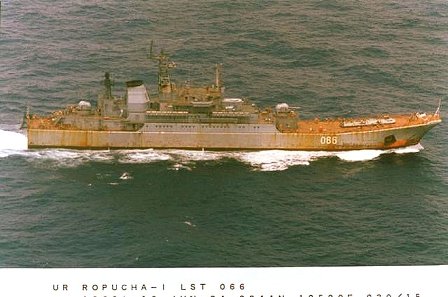Ropucha-class (Project 775)
Summary
| Origin country | 🇨🇳 Ex-USSR |
| Category | Amphibious vessel |
| Subtype | Landing craft transport |
| Manufacturer | Stocznia Północna Shipyard, Gdańsk, Poland |
| Year commissioned | 1974 |
| Units | 012 OLEGONORSKIY GORNJAK, 014 ALEKDANDR OTRAKOVSKIY, 016 N…, 027 KONDOPOGA, 035 N…, 039 N…, 055 N…, 066 MUKHTAR AVEZOV, 070 BOBRUYSK, 079 N…, 102 KALININGRAD, 110 ALEKSANDR SHABALIN, 127 MINSK, 142 NOVOCHERKASSK, 149 ORSK, 156 YAMAL, 158 TSEZAR KUNIKOV, 071 N…, 077 NIKOLAY KORSAKOV, 130 KOROLEV, 151 AZOV. U402 KONSTANTIN OLSHANSKIY |
| Current operators | 🇷🇺 Russia |
Description
The Ropucha class, known by its NATO reporting name (and Polish for "Toad"), comprises landing ships constructed for the Soviet Navy. Originating from Project 775, these ships were produced by the Stocznia Północna shipyards in Gdańsk, Poland, tailored specifically for beach landings and designed with the capability to carry a substantial 450-ton cargo. Unique to their design are both bow and stern doors for streamlined loading and unloading of vehicles across an expansive 630 square metre vehicle deck. Up to 25 armored personnel carriers can be loaded aboard either through roll-on/roll-off operations or via dockside cranes, courtesy of a sliding hatch-cover situated above the bow. These vessels notably lack helicopter facilities.
During their production span from 1975 to 1991, 28 Ropucha class ships were commissioned, with the final three being the advanced Project 775M, also dubbed Ropucha II, exhibiting superior troop accommodations and defense armaments. In the aftermath of the Soviet Union's dissolution, the majority of these ships were incorporated into the Russian Navy fleet.
The operational history of the class includes their utilization in the 2008 South Ossetia war for troop landings at the Georgian port of Poti and cargo deliveries during the Russian military intervention in the Syrian civil war. One ship served the Yemeni Navy from 1979 until 2002, marking the class's sole international service outside the former Soviet Union.
In 2012, amid heightened international attention, three Ropucha vessels visited the Russian naval base in Tartus, Syria. Furthermore, from 2013 onwards, ten ships carried military equipment to support Russian operations in Syria. Modernization efforts, such as the installation of advanced satellite communication systems, have occurred on all Black Sea Fleet ships.
During the conflict in Ukraine, a Ukrainian Ropucha-class ship was commandeered by Russian forces following the annexation of Crimea and integrated into the Russian Navy. In the lead-up to the 2022 Russian invasion of Ukraine, several ships from the Baltic and Northern fleets were deployed to the Black Sea for exercises. The class has seen recent action: in August 2023, the Olenegorsky Gornyak sustained serious damage from a Ukrainian maritime drone, and in September 2023, the Minsk was reported as "functionally destroyed" after a missile strike at the Sevastopol Shipyard, as assessed by the UK Ministry of Defence.
Technical specifications
| Ropucha | |
|---|---|
| Displacement | 4080 tons |
| Range | 11000 km at 12 knots |
| Endurance | 30 days |
| Crew | 98 members |
| Width | 15.0 m (49.2 ft) |
| Length | 112.5 m (369.1 ft) |
| Propulsion | 2 Zogda-Sulzer diesel engines with a power of 19,200 hp - 2 propellers |
| Armament | 4 SA-N-5 (IV 4) + 4 57mm AK-257 guns + 2 LR MRBL-122 122mm guns |
| Maximum speed | 18 knots |
Photo of Ropucha class
